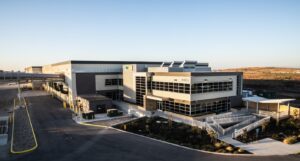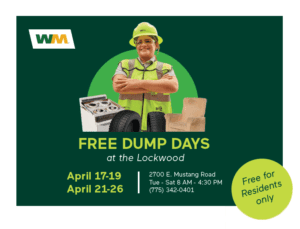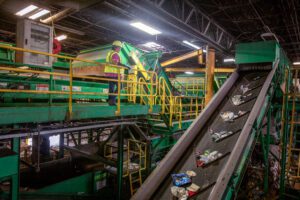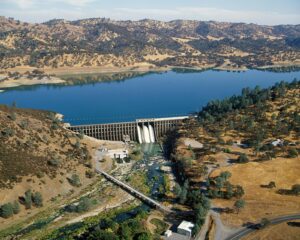Recycling & Reuse
Davis Street offers both Recycling and Reuse drop off for a variety of household and commercial materials including:
- Appliances
- Electronics
- Mattresses
- Motor Oil
- Tires
It is free to drop off aluminum and metal cans, cardboard, glass bottles, paper, and plastic bottles. For a complete list of recyclables and rates, check out our rate sheet.
Recycling Tips
|
Davis Street collects a variety of materials for recycling. Each material requires different processing to be turned into a new product.
Appliance Recycling
Refrigerators, ovens and other large household appliances can easily be recycled. Davis Street accepts all household appliances at our public drop off facility. Before an appliance can be recycled, we make sure to remove all of the hazardous chemicals and components such as Freon, mercury switches, capacitors and oil. These hazardous materials are safely and responsible recycled by licensed vendors.
The chemical-free appliance is taken to a metals recycler. Once at a recycling plant, the metal appliance is often shredded, melted and turned into metal casts or ingots. Finally, large masses of metal are sent to a manufacturing plant to be rolled into sheets. At this point, the metal is ready to be turned into new products such as cars, cans, boats, etc.
Using recycled steel has a positive impact on the environment, since it takes four times as much energy to manufacture steel from virgin ore as it does to make the same steel from recycled scrap.
Steel is America’s most recycled material. Approximately 75% of a typical major household appliance is made of steel. Major home appliances contribute about 10% of the recycled steel; more than 80% is derived from cars.
Each year Davis Street processes more than 3,000 appliances for recycling.
Battery Recycling
Today, 97% of automotive lead acid batteries are recycled in the USA. As a result, over 50% of the lead supply comes from recycled batteries.
Batteries are essential to our mobile lifestyle. Phones, music players, cameras and more make our lives convenient because of the power supplied by batteries. However, the chemicals that give batteries their “juice” are considered hazardous materials under California’s Universal Waste Rule and are banned from the California landfills.
The “juice” for batteries includes lead acid, nickel-cadmium, and nickel-metal-hydride. These are found in common household items like surge protectors, batteries, (AAA, AA, B, C, D), cell phones, and button batteries for cameras. Rechargeable batteries, while less hazardous, contain lithium-ion and are also recyclable.
The main objective for recycling batteries is to prevent hazardous materials from entering landfills. Some residents have curbside services for recycling household batteries. Check with your city to find out if this recycling program is available in your community. Regardless, all residents of Alameda County can recycle their batteries at the Household Hazardous Waste facilities in Oakland, Hayward and Fremont.
Once collected, recyclers sort batteries into like chemistries. The batteries are then broken apart and materials are separated for recycling. To learn more about the recycling process of each of these materials, visit: www.batteryrecycling.com/Battery+Recycling+Process.
Davis Street collects over 125,000 batteries each year for recycling.
Cardboard & Paper Recycling
Breaking down cardboard boxes saves room in your recycling cart and helps with the sorting process at the other end.
Paper, cardboard and newspapers come to the Davis Street Resource Recovery Complex from schools, businesses and households throughout Alameda County. Here we separate them into like materials and bundle them into bales for sale to mills for recycling.
Mills follow a specialized process to recycle paper products. Products generated from wood pulp, like paper, cardboard and newspaper are generally referred to as “fiber.” Fiber recycling produces clean pulp that is used to make recycled content paper and paperboard.
- Mills mix the fiber with water, drain and blend it into a pulp slurry using a giant blender called a pulper.
- Following pulping, the pulp mixture is diluted with water. Through a system of cleaning equipment and screens, large contaminants like wood, plastic, staples, glass and paper clips are removed.
- The resulting pulp is pressed to remove excess water and strip any residual inks.
- During the brightening process, chemicals are added to create white fiber.
- The final screening process removes any remaining glue particles or small contaminants.
The finished recycled pulp is either prepared for papermaking or formed into sheets for shipment and sale to another manufacturer.
Nearly 44 million pounds of fiber are processed at Davis Street each year.
Glass Recycling
Nearly 80% of recyclable glass containers in California are turned into new products by in-state glass recycling facilities.
Glass containers are an environmentally responsible packaging choice; nontoxic, high in monetary value, infinitely recyclable with no loss in quality or purity as its structure does not deteriorate with reprocessing.
Glass containers like bottles and jars can go from the recycling bin to the store shelf in as little as 30 days in California. Other types of glass such as windows, ovenware, Pyrex, windshields and crystal must be recycled separately; they have different melting points. For this reason, we only accept glass bottles and jars in the curbside recycling program.
When curbside recycling arrives at Davis Street, our Material Recovery Facility breaks the glass bottles and jars into small pieces called cullet. We send the cullet to our glass-processing partner who sorts and cleans it to prepare it for the recycling process. Cullet is mixed with silica, sand, soda ash and limestone to make new glass. These materials are mixed and heated to temeratures up to 2800° Fahrenheit, then molded into the desired shape.
The benefit of recycling glass is the reduction of energy. When glass is made from scratch, high temperatures are needed to melt and combine all of these ingredients. Since cullet melts at a lower temperature, the more cullet you add to a batch of raw materials, the less energy is needed to melt it.
Davis Street processes over 9 million pounds of glass each year for recycling.
Inerts Recycling
Toilets, sinks and other porcelain items, concrete, asphalt, bricks and cinder blocks can all be recycled at Davis Street. Our Public Area Materials Recovery Facility (PAM) separates construction and demolition materials to be recycled.
The Davis Street Resource Recovery Complex uses these materials on site for either construction projects or road projects. It’s also for sale through our WM EarthCare product line as Alcatraz Drain Rock.
Davis Street recycles over 21 million pounds of inerts each year.
Mattress Recycling
Mattresses and box springs are among the bulkiest and least-compactable items people throw away. Keeping them out of the landfill is better for landfill longevity and provides materials for new products. One mattress represents 23 cubic feet of recycling opportunities.
Its staff begins the recycling process by sorting out mattresses that are still in usable condition. Reusable mattresses are sent to community thrift stores in Oregon for resale. Unusable mattresses are deconstructed into their components: wood, metal, textile and cotton batting.
Approximately 1,500 pounds of polyurethane foam per day is recycled by St. Vincent de Paul. The balance of materials is recycled by others. Wood will be used in mulch, compost or energy production, metal springs are sold to metal dealers, and the cotton and fabrics are sold in the textile market.
Customers who bring their mattresses to the Davis Street Resource Recovery Complex are asked to help us reuse as many as possible by keeping them clean and stacking them neatly in the mattress area.
In 2010, Davis Street collected over 15,000 mattresses for recycling.
Metal Recycling
Metals can be recycled indefinitely without losing any of their properties. Recycling also reduces greenhouse gas emissions and the amount of energy used to make metal from virgin ore. For example, recycled aluminum uses 92% less energy compared to virgin ore metals.
The Davis Street Resource Recovery Complex has a variety of programs to collect metals. Our Appliance Program as well as the Residential, Construction & Demolition and Public Area Materials Recovery Facilities each capture metals for recycling. Monthly, we divert an estimated 1,000 pounds of metal from the landfill.
There are two main types of scrap metal: ferrous and nonferrous. Ferrous includes materials like tin, iron and steel. Objects like cars, appliances, and some food packaging are made from ferrous metal. Nonferrous metals include aluminum, copper and brass. Objects like soda cans, plumbing fixtures, nickels and dimes are made of non-ferrous metals.
Once recovered, Davis Street delivers the metals to recyclers. The cans and other materials are often shredded, then melted to turn into metal casts or ingots. The ingots are sold to manufacturing plants where it is rolled into sheets. At this point, the metal is ready to be turned into new products such as cars, cans, boats, etc.
Over 12 million pounds of metal are processed at Davis Street each year.
Motor Oil Recycling
In many Alameda County communities, curbside collection services include used motor oil for recycling. Where this is not offered, customers may bring up to 5 gallons per year of bearing oil or compressor oil to the Davis Street Resource Recovery Complex for recycling.
The following oils are accepted for recycling: crankcase fluid, cutting oil, differential fluid, gear box fluid, hydraulic oil, metal working oil, mineral oil, motor oil, stove oil, synthetic oil and transmission fluid.
Evergreen Oil in Newark, CA, collects waste lubricants from Davis Street to refine for lube oil. Re-refining is the chemical process that extracts the lubricating base stock from the waste lubricants. Water, fuel oil, additives and sludge are separated from the base stock. This involves vacuum distillation (using Wipe Film Evaporation) and hydro-treating (also known as hydro-finishing). This is the most successful acid-free commercial method of re-refining.
Davis Street recycles about 4,000 gallons of used motor oil each year.
Plastics Recycling
In 2008, over 234,000 pounds of plastic materials were deposited in Alameda County landfills.
Plastics are commonplace. From shopping bags and food containers to drink bottles and packaging materials, we use plastics everyday. It is important to use them responsibly and dispose of them appropriately. Many people are confused by the different types of materials and what can or cannot be recycled.
Important facts:
The chasing arrows symbol found on the bottom of plastic products is an indication of the type of plastic, not that they are recyclable
Most rigid plastics are recyclable through Davis Street’s curbside programs
1 PETE
Material: Polyethylene Terepthalate (PET) Used For: Soda & water bottles, peanut butter jars and cooking oil bottles. Recycled Into: Fleece, carpet, polyester products Where: USA
2 HDPE
Material: High Density Polyethylene (HDPE) Used for: Milk bottles; detergent bottles, some plastic bags Recycled Into: Plastic lumber, curbs, trash cans Where: USA
3 V
Material: Polyvinyl Chloride (PVC) Used for: Salad dressing, detergent, shampoo bottles, toys, pipes Recycled Into: Vinyl flooring, billboards, carpet backing Where: USA
4 LDPE
Low-Density Polyethylene (LDPE) Used for: Produce and shopping bags Recycled into: Garbage bags Where: Not Collected by Davis Street for recycling
5 PP
Material: Polypropelylene (PP) Used for: Bottle tops and drinking straws Recycled into: Ice scrapers, trays, yard & garden tools Where: Not Collected by Davis Street for recycling
6 PS
Material: Polystyrene (PS or EPS) Used for: Polystyrene foam meat and take-out trays, cups, packaging materials Where: Not Collected by Davis Street for recycling
7 OTHER BIO PLASTICS
Material: Other Used for: This is a catchall for plastics resins or mixes of all of the above in the same product. Not readily recyclable Material: Plant-based resins often combined with chemical resins Used for: plastic bags, utensils, plates & cups Not Recycled in the traditional sense that it creates a new product; it breaks down in a relatively short period of time in landfills, something traditional plastic does not do. If composted, the resulting compost does not meet the Organic Materials Review Institute standard for use in organic farming.
Davis Street recycles over 14 million pounds of plastics per year.
Yard Debris & Food Scraps
The organic materials collected from household green carts across Alameda County are a source of nourishment for our local soil. Davis Street is closing the loop on this material. We send it to our composting facility at the Redwood Landfill & Recycling Center and return it as Organic Materials Review Institute (OMRI)-listed compost to our WM EarthCare Landscape Center.
With more than 1,000 tons of organics passing through our LEED™ Gold Organics Processing and Transfer Facility daily, we also send material to third-party composters. At our composting facility in Marin County, yard trimmings and food scraps are ground and then arranged in windrows (piles about 4’ high; 8’ wide and 200’ long) to begin composting. Composting involves providing an ideal environment for microbes combined with oxygen and water to break down – or rot – the feedstock.
As the microbes break down your peach pits, spoiled vegetables, bones, leaves and branches, they generate heat that is crucial for killing pathogens and weed seeds. Temperatures within compost piles can reach as high as 160°. After 17 weeks, the result is a stable, decomposed, organic material called humus. This well-balanced, nutrient-rich, dirt-like substance is ready for use in gardens and farms.
Using compost in your landscape helps to nourish your soil and plants naturally. You are also nurturing our planet by using recycled materials instead of chemical fertilizers and herbicides.
Davis Street diverts nearly 296 million pounds of yard trimmings and food scraps for composting each year.
Wood Recycling
Wood is recovered from our Construction & Demolition and Public Area Material Recovery Facilities (MRFs). Employees carefully sort wood materials for recycling – either for mulch or biofuel. Much of the wood collected at Davis Street is sent to our WM EarthCare facility in Fremont. Here we grind the clean, untreated wood for mulch, using a magnet to recover all the nails. The resulting ground product is dyed using naturally occurring dyes produced by our partner, Amerimulch. We are closing the loop on wood scraps, keeping the material local to help prevent soil erosion, improve water retention and contribute to soil structure.
Painted, pressure treated and composite materials are not suitable for the WM EarthCare mulch products. Where appropriate, the wood is used in power plants throughout California.
When the biomass is burned, it produces heat which turns water into steam. The steam turns turbines, which are connected to electric generators.
Some materials, like chemical treated telephone poles must be landfilled.
Davis Street recycles over 26 million pounds of wood each year.




